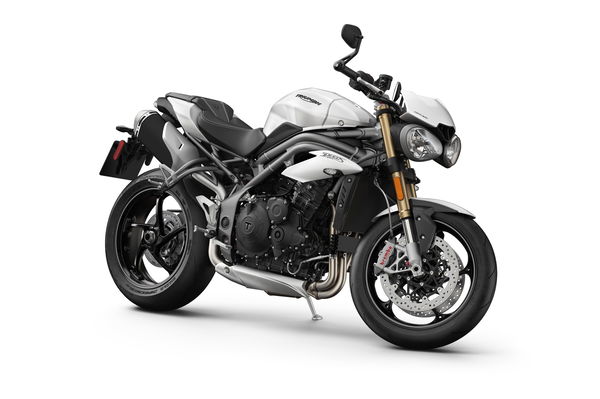Honda CB125R: Thinking big, acting small
Honda's 2018 CB125R has big bike looks and style, in a small-bore package

It's one of the great ironies about bikes, that big bikes often want to be small, while small bikes generally try to be big. When you're building a new superbike, you want the mass to be minimal and the fairing to be svelte – all the better to maximise the gigantic performance inside the teeny-tiny chassis.
Meanwhile, your colleagues in the design department down the corridor are simultaneously trying to make their new learner-legal machine look as much like the big boys as they can. Hence, Honda's old CBR125 would be slathered in Repsol paint, with slit-eye headlights, much like the CBR1000RR Fireblade. The performance inside is marginal, but the looks on the outside are (trying to be) monstrous.
The reasons are obvious. Many learners are young folk, who one day hope to be manhandling a 200bhp superbike about, so selling them a 125cc version makes sense. And while sportsbikes may have declined in popularity, the principle also applies to other classes.
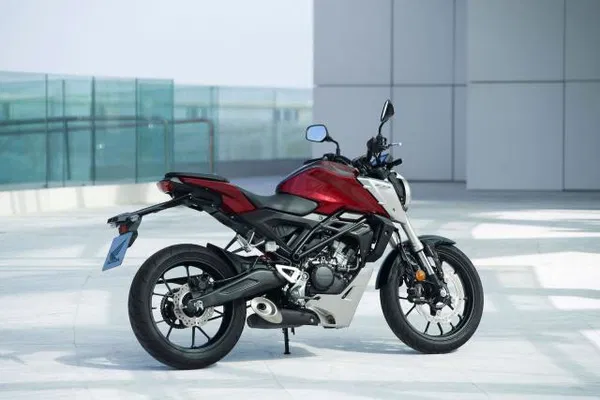
Which brings us (finally!) to the CB125R which I am here in Lisbon to ride. It's, obviously, a learner-legal 125, which is restricted in terms of power and power-weight (to a maximum of 14.7bhp/11kW, and no more than 0.1kW per kg of mass). But at first glance, it looks like a far bigger machine. That's on purpose of course – this is the smallest version of Honda's new 'Neo Sports Café' design language, which we are also getting in CB1000R and CB300R forms later this year. It's a style direction that Honda's been trialling for the past few years in concept form at bike shows, and while I wasn't 100 per cent on it at first, it's now grown on me. There's a high-quality feel to it – with aluminium sections on the bodywork, a distinctive round LED headlamp, and shapely frame and swingarm (shared with the CB300).
Leaving our hotel for the first ride out on the CB125R, it certainly looks like a bigger bike. Indeed, I walk up to one of the outriders' CB650s at first, and almost put my gloves on it, so closely does the smaller bike ape its bigger siblings. I quickly shuffle along the line to a proper CB125R before anyone notices, and slip on my Shark lid…
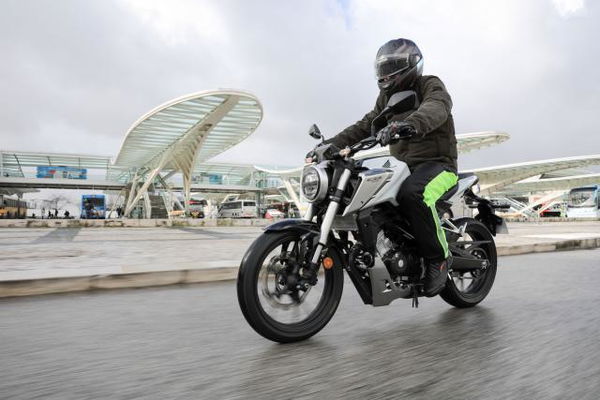
Iberian rain
The weather is, to be kind, a bit ropey. We were supposed to go out on the bikes for an evening ride last night, but some Glasgow-spec rain put that on ice, so this morning is our first session. And the signs are not good. The forecast is better this afternoon, but in the meantime, we have heavy showers and strong gusting winds. Living the dream, as ever.
I have decent new Alpinestars waterproofs and boots though, so I kit up and we head off into Lisbon city centre for the first photo stop. The CB is comfy, and just about low enough in terms of seat height for my 29-inch inside leg. There's a good quality feel to the LCD dash and switchgear, but I'm sad that the front brake lever hasn't earned a span-adjuster dial. Last night, the Honda staff were keen to point out the quality of things like the pillion pegs, brake calipers, fat handlebar and the shapely mirrors – but I think I'd have traded a few quid's worth of stuff somewhere else for the instant luxury of an adjustable brake lever.
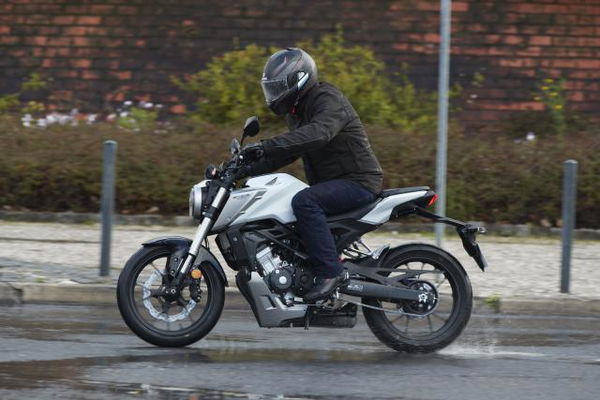
Engine
Pulling away, there's the usual despondency about the lack of power on a learner bike. Of course, that's not Honda's fault, but the first few miles really hit home how low the learner power limits are. We adjust quickly though, and I soon settle into the slow-lane groove. The engine is pleasing enough in that context – there's decent torque low-down, and some semblance of a normal power delivery. If you're old enough to remember some of the restricted 125 two-stroke 125s of the 1980s and 90s, you'll know just how much of an abortion a badly-restricted 125's power curve can be. Nowadays though, 125 engines are four-strokes, designed to this power output, and so engineers can put effort into making them perform in a more satisfying way.
The fun's still there of course. It just takes place 40mph slower than on a big bike. Cutting through mad Portuguese traffic, the CB works well – when you get your gearchanges right, and slip the clutch at just the right moment, you can make almost any gap, and I'm just about able to keep up with the Africa Twin that's leading our group. The throttle is essentially a switch – either off when we're stopped at a red light, or at 100 per cent when moving. Even changing gears is best with full-throttle, a fast dip of the clutch all you need to hook up another ratio in the slick six-speed box.
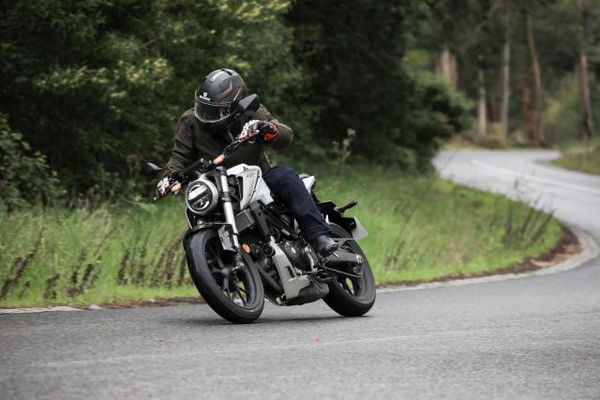
Chassis
With the engine sussed, it’s time to look at the rest of the bike. The rain's heavy now, so I'm thinking about grip on the cobbles and tram lines round here. The CB125 has fairly wide wheels and tyres – a 3" front and 4" rear rim, with 110/70 front and 150/60 rear rubber. The Dunlop GPR-300 tyres are doing good work here actually, and while there's a bit of moving about and slip-sliding on the worst polished asphalt, I never feel in danger. That's a big change from the old days, when small bike invariably had rotten, bakelite-effect hoops.
The other big change is in the brakes. Of course, like all new bikes, the CB125R has ABS, and Honda's quite pleased that they've managed to fit a system with an IMU unit. It's not there for leaning ABS though, rather, the ECU uses the info on pitching from the IMU in order to optimise the front and rear braking effort for stability, and to stop the rear end lifting too much when hard on the front brake. The brakes themselves are decent enough, with good levels of power, albeit with a slightly soft initial bite.

What they do though is show up the quality of the front fork in particular. These 41mm USD units have a nice Showa logo embossed in the top plug, and while they're obviously devoid of adjustment, they're very decent for a 125. Honda's fitted them to the CB300 too, and while the suspension action is a little soft and bouncy the forks and shock are definitely a step above the basic fare often used on learner machines.
We're finished in town now, and are heading alongside the river Tagus towards Cascais, the chi-chi coastal town on the outskirts of Lisbon, for a coffee stop. The road here is wider and faster, but the CB is able to keep up with the 40-50mph traffic flow easily enough. The rain is getting proprely biblical though, and with zero protection available anywhere on the little naked machine, I'm soon dripping wet. Luckily, my kit is keeping me dry on the inside, but it's still a fairly miserable schlepp out to Cascais, where we stop and defrost in a lovely café, while the sun gradually appears outside. The line of CB125Rs looks good in the harbour area, the classy paint jobs, aluminium highlights and full-LED headlights matching Cascais for sophistication and style.
Out on the twisties
Back on the bikes, and we squelch our way inland, to Sintra, Lisbon's other chic locale, for lunch. There's some twisty back road sections here, and I quickly end up dicing with a nice Swiss fellow, chasing down the Africa Twin leading the way. Uphill, the struggle is about getting every last half-horsepower out of the motor, tucking in, changing up and down gears like a possessed 125GP racer from the 1960s, and judiciusly slipping the clutch to get the LCD revcounter up another 250rpm into the power. Invigorating stuff! Downhill though, it actually feels more like normal bike riding – you can keep the momentum up, and braking and turning become important again. The little CB chassis does well here actually, and I get the impression than the CB300 will be a real laugh when it appears, with more than twice the power, in very similar running gear. The 125 claims to be the lightest in its class, at just 125.8kg wet, and that, plus the long swingarm and stiff frame, actually makes it quite a sharp performer mid-bend.

After a nice rustic lunch, we're heading back to the hotel, taking in some proper motorway along the way. I get the chance to go flat-out on the CB, and manage to hit 130-135kph on the dash. That's about 80-83mph, and not bad for a restricted naked 125. Even more impressive is the fuel consumption on show at the end of the day – despite my constant thrashing of the little bugger, it's showing 37km/litre, or over 100mpg. Ridden by someone behaving like a normal human being, I'm sure it'll do a fair chunk more.
Once again then, the CB125R manages to do big things, while remaining small. Big bike looks, big styling, big quality and big mpg, all with small weight, small running costs and small, learner-legal power. And if you're lucky enough to be riding one of these as a new rider, then I reckon you'll have some pretty big amounts of fun on it.
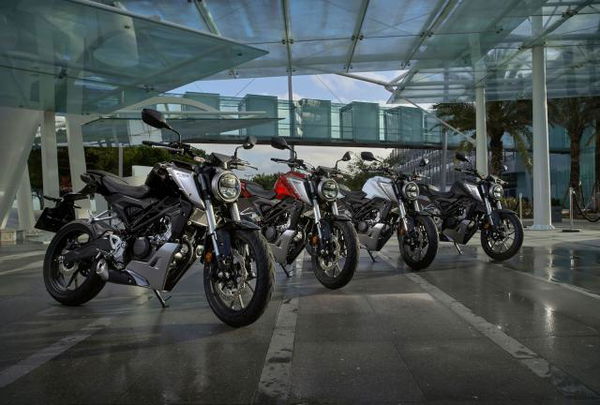
Specifications
Price: £3,949
Engine: 2v single, SOHC, liquid cooled, 124.7cc
Bore x stroke: 58x47.2mm
Compression ratio: 11:1
Max power (claimed) 13.1bhp@10,000rpm
Max Torque (claimed) 7.4ft lb@8,000rpm
Transmission: six speed, chain drive
Frame: steel tube trellis
Front suspension: 41mm Showa USD forks
Rear suspension: monoshock
Brakes: Single 296mm wave disc, four-piston Nissin caliper (front), 220mm disc, single-piston Nissin caliper (rear), IMU-assisted ABS
Wheels/tyres: Aluminium/Dulop GPR-300, 110/70 17 front, 150/60 17 rear
Rake/trail: 24.2°/90.2mm
Wheelbase: 1,345mm
Seat height: 816mm
Weight (claimed, kerb weight): 126kg
Fuel capacity: 10.1 litres
